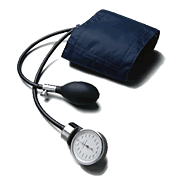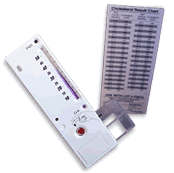Checklist for Getting a Checkup
R.Beamish
Americans see their doctors for checkups more than
any other reason. The goal: warding off disease. But screenings for “early
detection” may not be the answer for all of us, experts say. While research has developed many tests to spot disease,
debate swirls about screening for such scourges as cancers of the breast and prostate.
False positives, traumatic effects from treatment and scientific questions about longterm
mortality improvement have left questions about the timing of screenings and even their
basic value.
 So how can you
tell whether you are getting the right tests? A good place to start is a blueprint for the
routine checkup was developed in 1995 by a federal task force that reviewed 6,000 studies
on 70 maladies. The result is a handful of screenings that the U.S. Preventive Services
Task Force believes physicians should administer to the general population.
So how can you
tell whether you are getting the right tests? A good place to start is a blueprint for the
routine checkup was developed in 1995 by a federal task force that reviewed 6,000 studies
on 70 maladies. The result is a handful of screenings that the U.S. Preventive Services
Task Force believes physicians should administer to the general population.
The task
force recommends tests for blood pressure, cholesterol, colorectal cancer and breast and
cervical cancer.
In failing to
recommend widespread screening against other disease, the task force generally cited two
reasons: either the tests have been found to have no merit, or there is not enough hard
scientific evidence to prove their benefit.
Here's the rundown of the tests the task force does
recommend:
| Blood pressure screening for hypertension. Recommended for adults and children, the test uses a gauge called a manometer that is connected to a large inflatable cuff attached tightly around the arm. The cuff is squeezed around the arm to produce the blood pressure reading. Hypertension, which afflicts an estimated 43 million adults, can lead to heart disease, stroke and renal disease. The task force says lowering high blood pressure can reduce coronary heart disease by 14 percent and strokes by 42 percent. In addition to a healthy diet and exercise, treatment may entail drug therapy. | |
 Blood tests to measure cholesterol levels, a sign of the
nation's deadliest malady, coronary heart disease. The task force and other groups
recommend periodic testing for men ages 35 to 65 and women ages 45 to 65. A test every
five years will suffice for those who have no family history or other risk factors, says
the National Cholesterol Education Program of the Health and Human Services Department.
The agency also advocates breaking out the so-called good (HDL) and bad (LDL) cholesterol
from total blood cholesterol as the only sure way to use the levels to predict heart
disease. The task force is likely to update its current guideline to include that
breakdown, says task force coordinator Dr. David Atkins. Blood tests to measure cholesterol levels, a sign of the
nation's deadliest malady, coronary heart disease. The task force and other groups
recommend periodic testing for men ages 35 to 65 and women ages 45 to 65. A test every
five years will suffice for those who have no family history or other risk factors, says
the National Cholesterol Education Program of the Health and Human Services Department.
The agency also advocates breaking out the so-called good (HDL) and bad (LDL) cholesterol
from total blood cholesterol as the only sure way to use the levels to predict heart
disease. The task force is likely to update its current guideline to include that
breakdown, says task force coordinator Dr. David Atkins.Cholesterol testing for children is required only if a parent or grandparent has high cholesterol, but children should eat a low-cholesterol diet in any event, NCEP says. Some groups recommend screening people as young as 19, but the task force is unconvinced that screening is any more beneficial than counseling young people on healthy diet and exercise. | |
| Screening for colorectal cancer, the nation's
second most deadly cancer after lung cancer. Colorectal cancer causes 56,500 deaths a
year, with older people and African-Americans the most susceptible. The White House
recently launched a campaign to raise awareness about the disease and screening.
"This is something that many internists and primary care doctors
underrecommend," says Manhattan gastroenterologist Scott Weber. Only 38 percent of
people over 50 said they had ever had a sigmoidoscopy, the frequently recommended test,
according to a nationwide survey by the Centers for Disease Control and Prevention.
Testing is widely recommended for people over 50, but there is debate over which methods,
none of them pleasant, are best. Dr. Weber prefers the most comprehensive test, a colonoscopy, which requires sedation, advance fasting and laxatives and use of a 4-foot tubular scope through the rectum to look for cancerous or precancerous polyps. But the task force and many physicians call for colonoscopy only as a follow-up to routine screening of fecal samples and/or sigmoidoscopy. The sigmoidoscopy, which uses a flexible probe in the rectum, cannot see as far as the colonoscopy, but is less expensive and less uncomfortable and requires no sedation. Another testing regime is a barium enema; but if the X-ray finds anything, the patient typically will undergo a colonoscopy anyway, Dr. Weber says. The American Academy of Family Physicians gives equal weight to all four tests after age 50 — with the colonoscopy performed every five years — while the task force recommends annual tests for fecal blood and/or sigmoidoscopy every five years. | |
| Pap smears to detect precancerous lesions that
can result in cervical cancer. The test is recommended for women who have been or are
sexually active and is typically done in conjunction with a manual pelvic exam. A woman's
cervix is scraped with a brush to collect cells for evaluation under a microscope. The
task force recommends the test every three years. But many physicians order it, and women
expect it, each year. Pap smears often result in false positives, with abnormal cells due to yeast infections, use of spermicidal jelly or inflammation, says Dr. Joann Elmore, an internist and associate professor at the University of Washington School of Medicine. As many as half the false positives are due to interpretive mistakes in the lab or poor sampling technique, according to the Health and Human Services Department. But fancy new technologies are not necessarily any better than traditional Pap testing, says the American College of Obstetricians and Gynecologists. The Food and Drug Administration has approved three new techniques — two involving computer-assisted analysis and one a new laboratory process — that are more sensitive than the traditional Pap, and more expensive by as much as $40. But ACOG says there is insufficient data to show they reduce cancer incidence or improve the survival rate. Thus, the new procedures "do not represent the current standard of care in cervical cancer screening," ACOG announced this summer. "New does not necessarily always mean better," says Dr. Stanley Zinberg, ACOG vice president. | |
| Mammograms, an imaging technique to look for
breast cancer, the most commonly diagnosed cancer in women. The disease kills an estimated
43,900 women a year. The breast is compressed between two plates for an X-ray showing
dense spots or tiny specks of calcium that may herald cancer. Surgery is typically
recommended to remove the cancer cells. Mammography detects cancer an average 1.7 years
before a woman can feel the lump herself and also locates cancers too small to be felt in
a clinical breast exam, according to CDC data. Opinions vary on the optimal frequency for mammograms, yearly or every other year. But the real conundrum is whether a woman should begin such testing at age 40 or 50. The rate of false positive results is higher among younger women, possibly because those in the 40 to 50 age group have denser breasts than those over 50, says Dr. Elmore. She conducted a survey that found a woman has a 50 percent chance of getting a false positive over 10 years of annual mammograms. Those women endure intense anxiety and sometimes disfiguring biopsies before learning they don't have cancer after all, she says. Dr. Elmore recommends that her patients over 50 get mammograms every one or two years — and for those in their 40s, "I allow them to decide." The American Cancer Society and American College of Obstetricians and Gynecologists urge all women over 40 to undergo mammograms. The U.S. task force says there is not enough evidence to recommend for or against for women under 50. |
Perhaps
the most controversial stance of the task force is its stand against screening for
prostate cancer — either by manual exam or so-called PSA, prostate specific antigen
screen. The American Cancer Society urges PSA testing, as well as a digital rectal
examination annually for men over 50. Other groups say doctors should discuss the pros and
cons with patients.
Prostate cancer claims some 39,000 lives a year and
hits black men hardest. The PSA test measures a protein in the blood that can indicate
cancer and other prostate abnormalities. The follow-up test entails insertion of a needle
through the rectum and into the prostate to collect biopsy material.
Surgical removal of the prostate is a common
intervention, but some experts are hesitant. "There is not yet conclusive evidence
that early detection can reduce prostate cancer mortality," writes the task force. It
also cited "adverse consequences of widespread screening," including false
positive results, unnecessary biopsies and "harms from aggressive treatments for
indolent cancers that may never have caused symptoms in a patient's lifetime." Side
effects of surgery and radiation, another treatment, often include incontinence and
impotence.
If a man in
his 50s has advanced prostate cancer, surgery is a more obvious choice than in an elderly
man whose tumor may grow so slowly that he dies before suffering its effects, says Dr.
Matthew McKenna, CDC branch chief of epidemiology. Even still, he says, "that's a
tremendous source of controversy. From a scientific standpoint, it's an open
question."
But many prostate cancer survivors and their
advocates swear by the PSA test. "If you have prostate cancer, it's a whole lot
better to know and to do something about it," says Christopher Noxon, communications
director of the Association for the Cure of Cancer of the Prostate.
Widespread research is continuing, and the task force
probably will look at PSA testing again, along with other tests — for diabetes and
thyroid disease, for instance — that have been the subject of new research, Atkins
says.